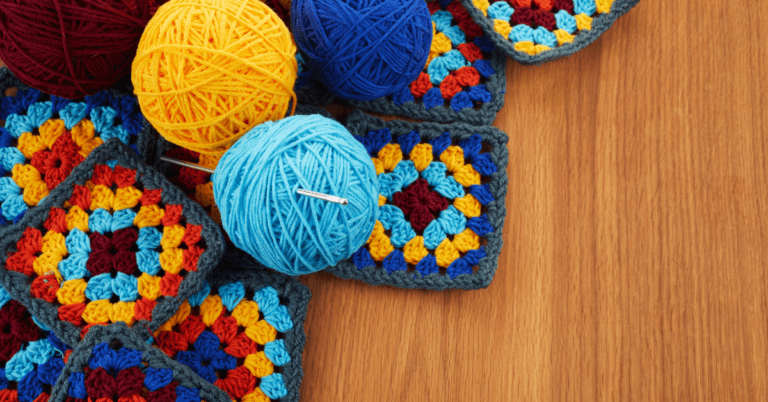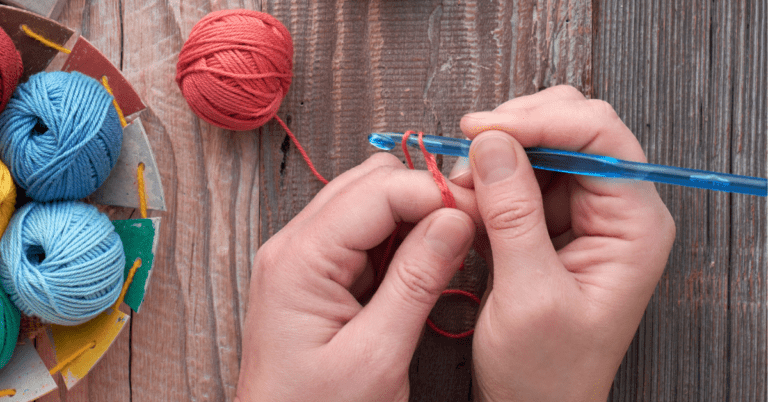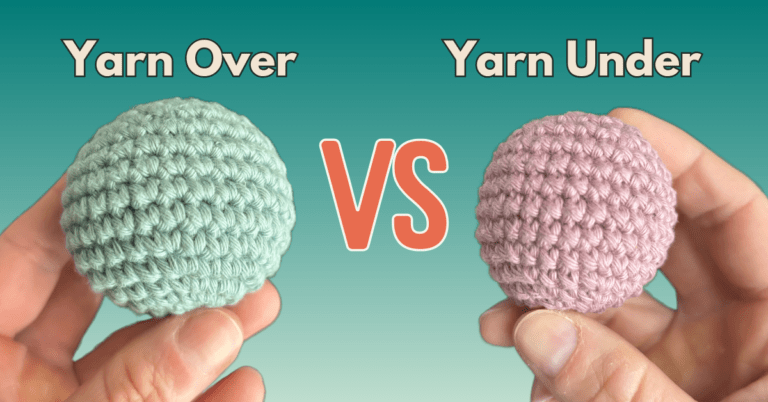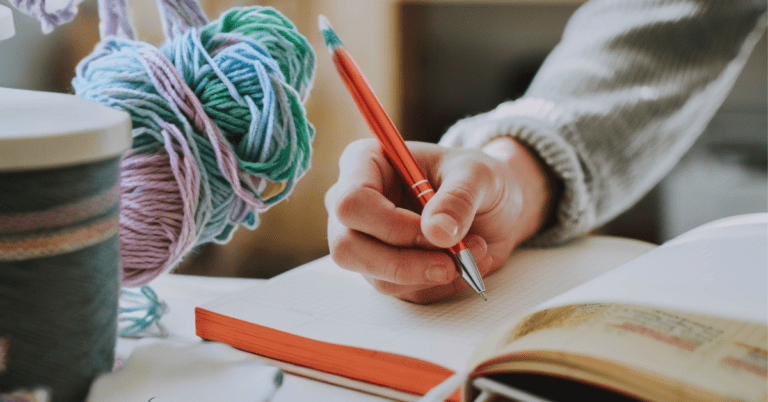The 6 Basic Crochet Stitches Explained: A Beginner’s Guide

In this beginner’s guide, I will share with you a step-by-step tutorial on how to make the 6 basic stitches in crochet and by the end of this article you’ll have a good understanding of the fundamental skills needed to be on your way to create your first crochet masterpiece.
You have finally decided to give crochet a go, but have no idea where to start. I hear you, I have been there.
In fact, at the beginning of my crochet journey, while my Instagram feed was filled with amazing crochet projects and lots of inspiring ideas, my crochet skills were instead not even close to putting together yarn and hook.
Fear not! it’s going to take you just some practice and simple instructions to get you started.
What are the basic crochet stitches?
To start, every crocheter, independent from their level of experience, will tell you that mastering the basic stitches is crucial to build your skills, read and adapt patterns, but most importantly to create any project you want to achieve.
In fact, these stitches form the foundation of all crochet projects. They are the building blocks from which more intricate patterns and designs are created.
The 6 basic stitches you’ll learn about are:
- Chain Stitch
- Single Crochet
- Half Double Crochet
- Double Crochet
- Treble Crochet
- Double Treble Crochet
By mastering these stitches you will be able to create various textures, patterns, and designs, empowering you to bring your creative ideas to life.
Worth to know: In this step-by-step guide I am using US crochet terms and showing right-handed instructions. If you are more familiar with UK terms, check this handy conversion chart in my article: “Why are UK and US Crochet Terms different?”.
Materials You’ll Need for the Basic Crochet Stitches
Before we dive into the basic crochet stitches, let’s first gather our materials:
You can choose any type of yarn you like, but as a beginner, I would recommend to start with a medium-weight yarn in a light colour, as it’s easier to work with and see clearly your stitches.
Crochet hooks are available in different sizes, and the size you’ll need depends on the yarn you’re using. Check on the yarn label as it will tell you the recommended crochet hook size to be used with it. In general, the thicker the yarn, the larger the hook size you will need to use with it.
Check some of my favourite hooks HERE.
Chain Stitch
The chain stitch in crochet is one of the most fundamental and essential stitch. In particular, it is very simple to make and it serves as the building block for most crochet projects. You’ll find it very often mentioned as the first step in the majority of patterns as it is the starting point for creating a foundation chain.
Abbreviation in patterns: (CH) across both US and UK terms
To create a chain stitch:
1. Start with a slip knot on your hook.
If you are not familiar with the slip knot, check out these 5 ways to make a slip knot for beginners.

2. Yarn over (meaning: wrap the yarn around the hook from under to over).

3. Pull the yarn through the slip knot.
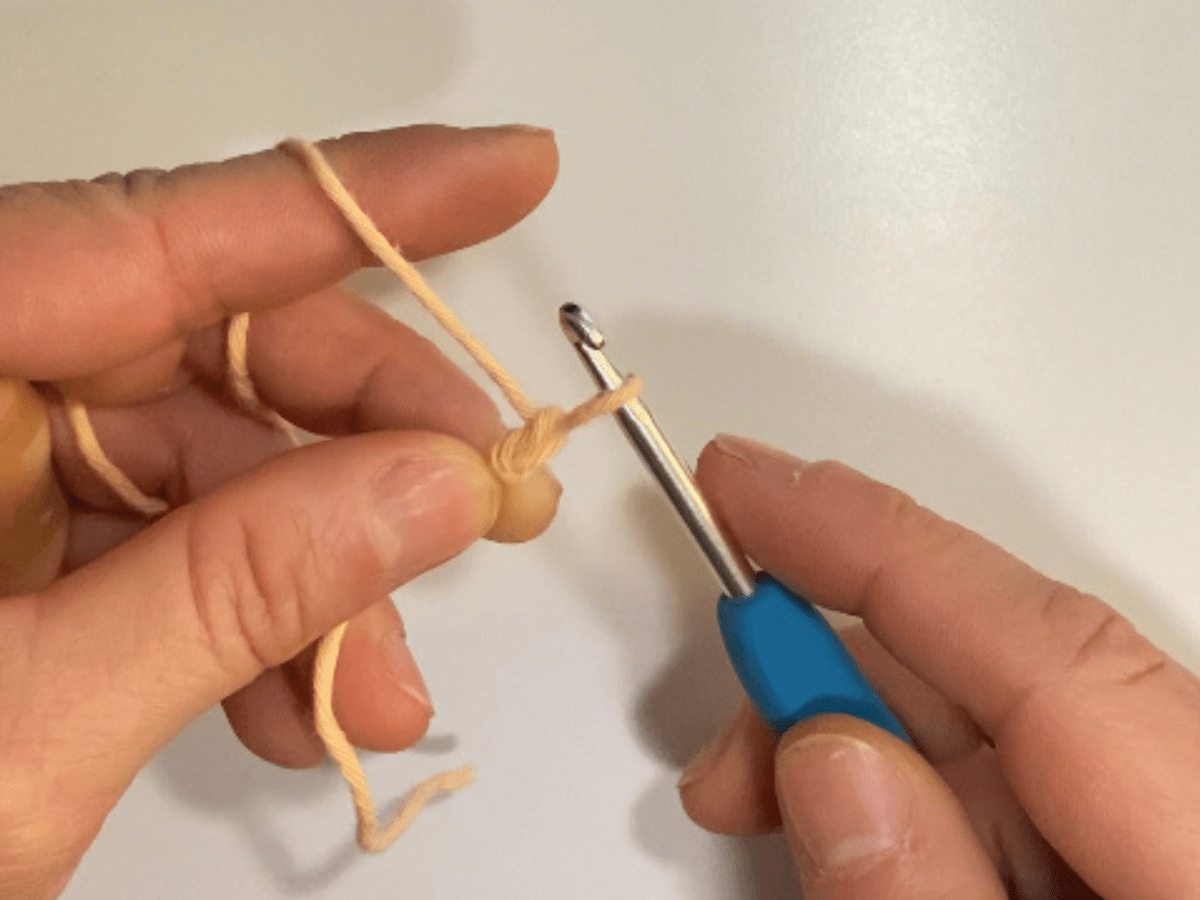
That’s it! You’ve just created your first chain stitch! Now you can repeat this process to create as many chain stitches as your pattern requires. For example a 10 chain stitches will look like this:
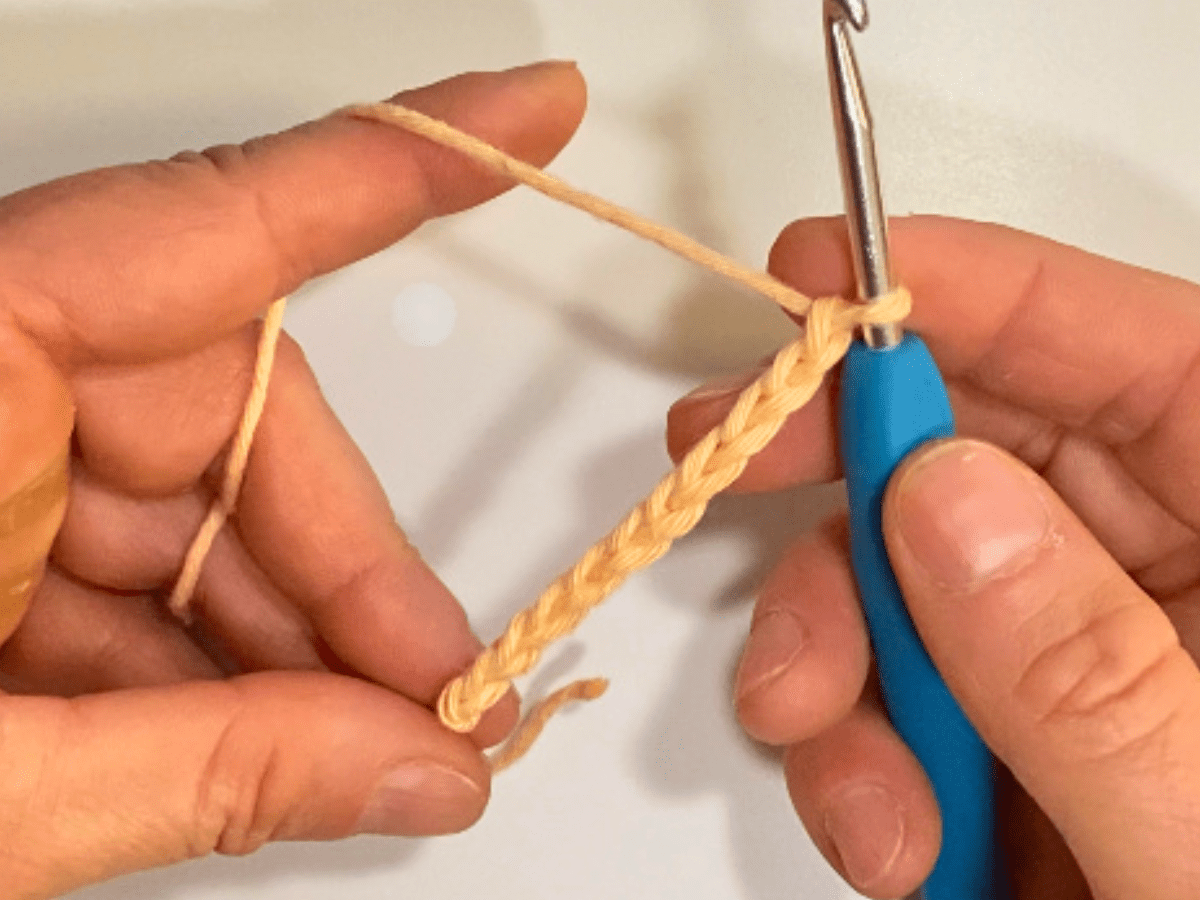
Single Crochet
The single crochet stitch is the simplest and most basic crochet stitch. As a beginner, you’ll discover it to be the first stitch to learn, due to the fact it serves as the foundation for many crochet projects. It creates a tight and dense fabric, making it ideal for projects like dishcloths and amigurumi or for projects that require a sturdy structure.
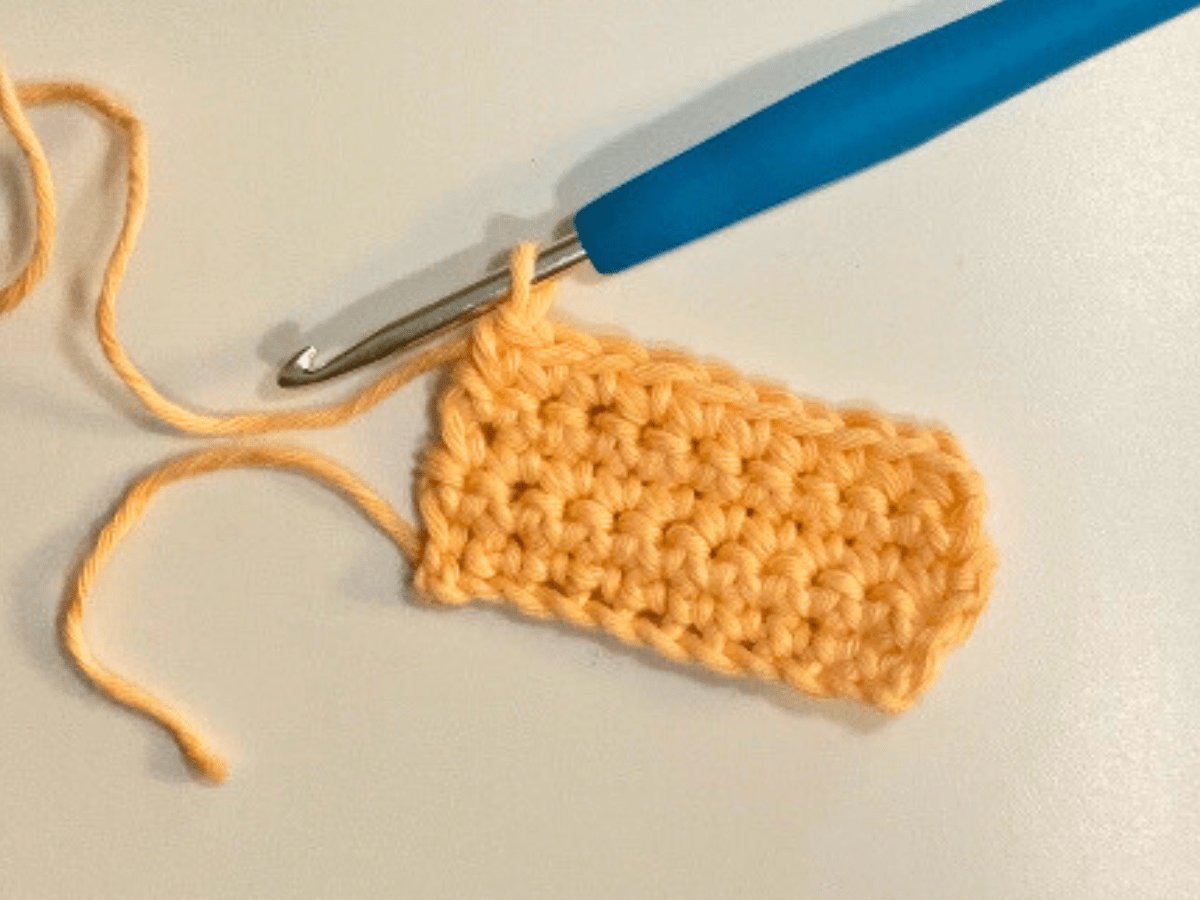
Abbreviation in patterns: (SC) in US term and (DC) in UK terms
To make a single crochet:
1. Insert your hook into the desired stitch.
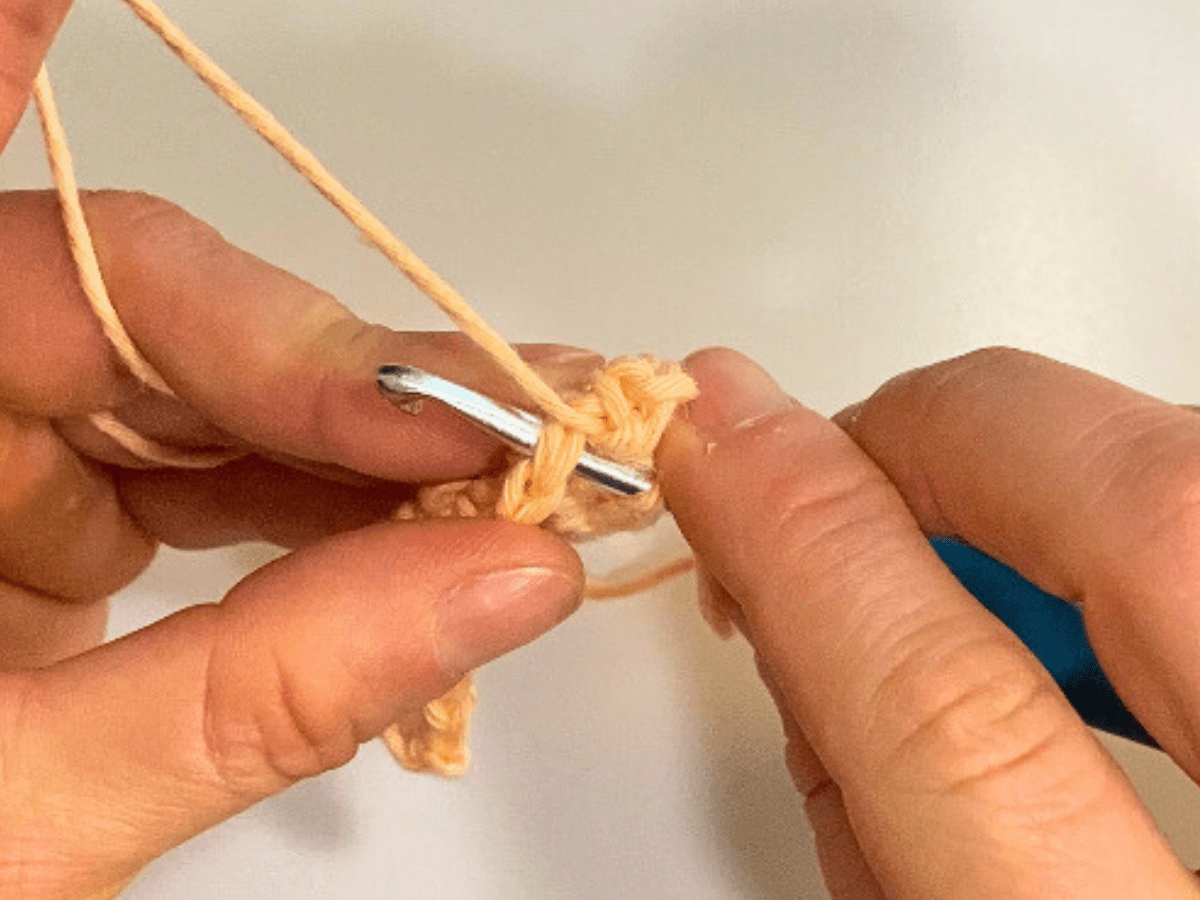
2. Yarn over and pull up a loop. You’ll have 2 loops on your hook.
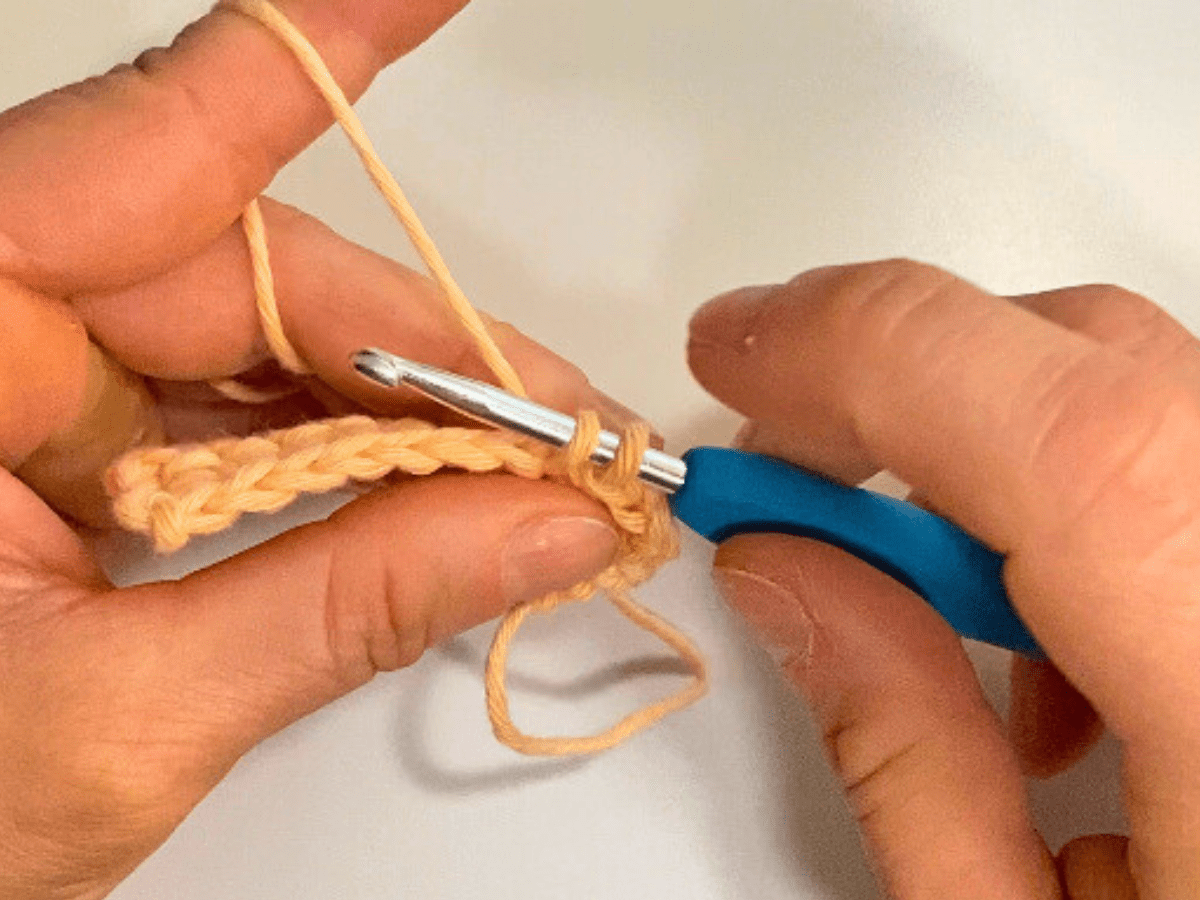
3. Yarn over again and pull through both loops on the hook.
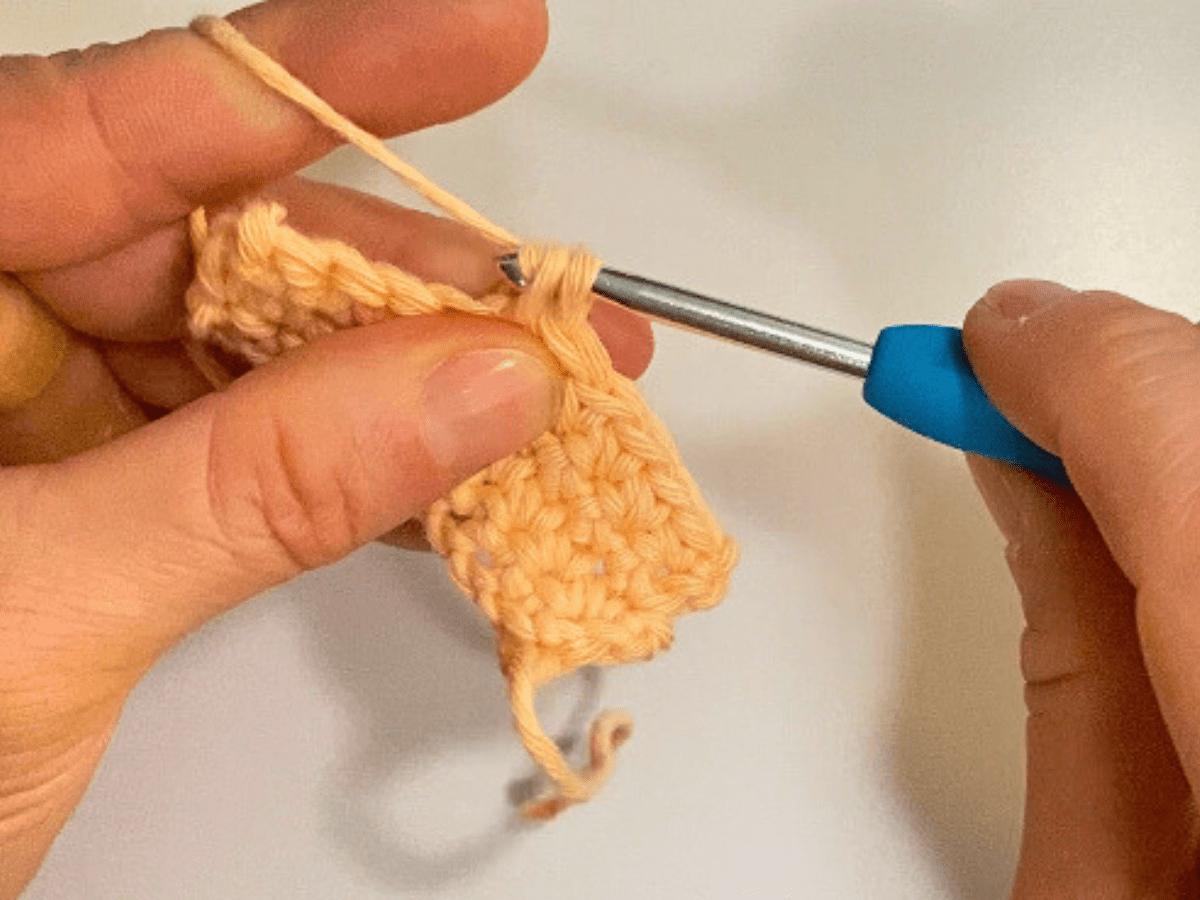
Simple right?! Now, why don’t you practice the single crochet stitch and make some rows or rounds with it?
Half Double Crochet
The half double crochet is a bit taller than the single crochet and has a bit more flexibility. It results in a fabric that is not as dense as the single crochet, but also not as open as if you would use the double crochet.
This is a stitch which can be very versatile, in fact the half double crochet stitch is commonly used for a variety of projects, including scarves, hats, blankets, and garments, offering a good compromise between density and drape.
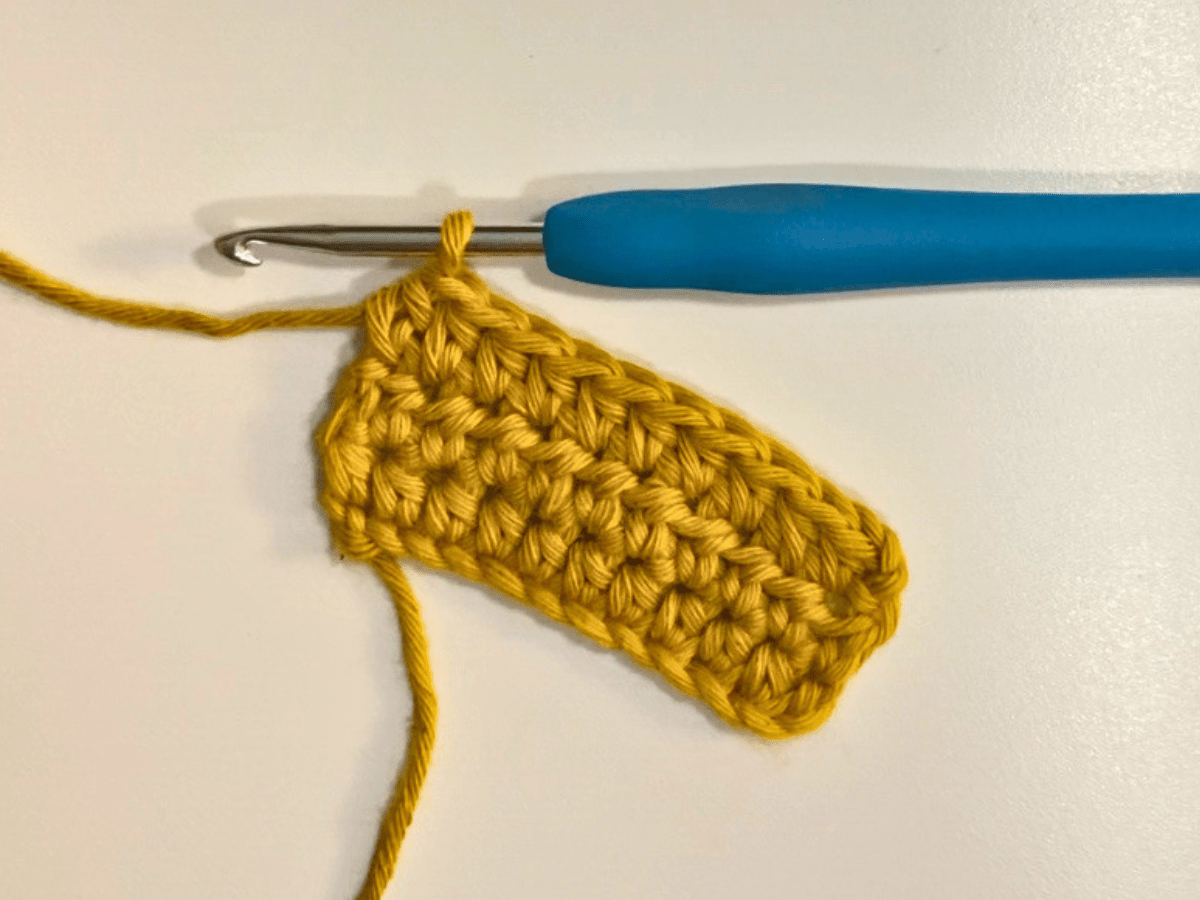
Abbreviation in patterns: (HDC) in US term and (HTR) in UK terms
To make a half double crochet:
1. Yarn over and insert your hook into the desired stitch.

2. Yarn over and pull up a loop. You’ll have 3 loops on your hook.

3. Yarn over again and pull through all three loops on the hook.
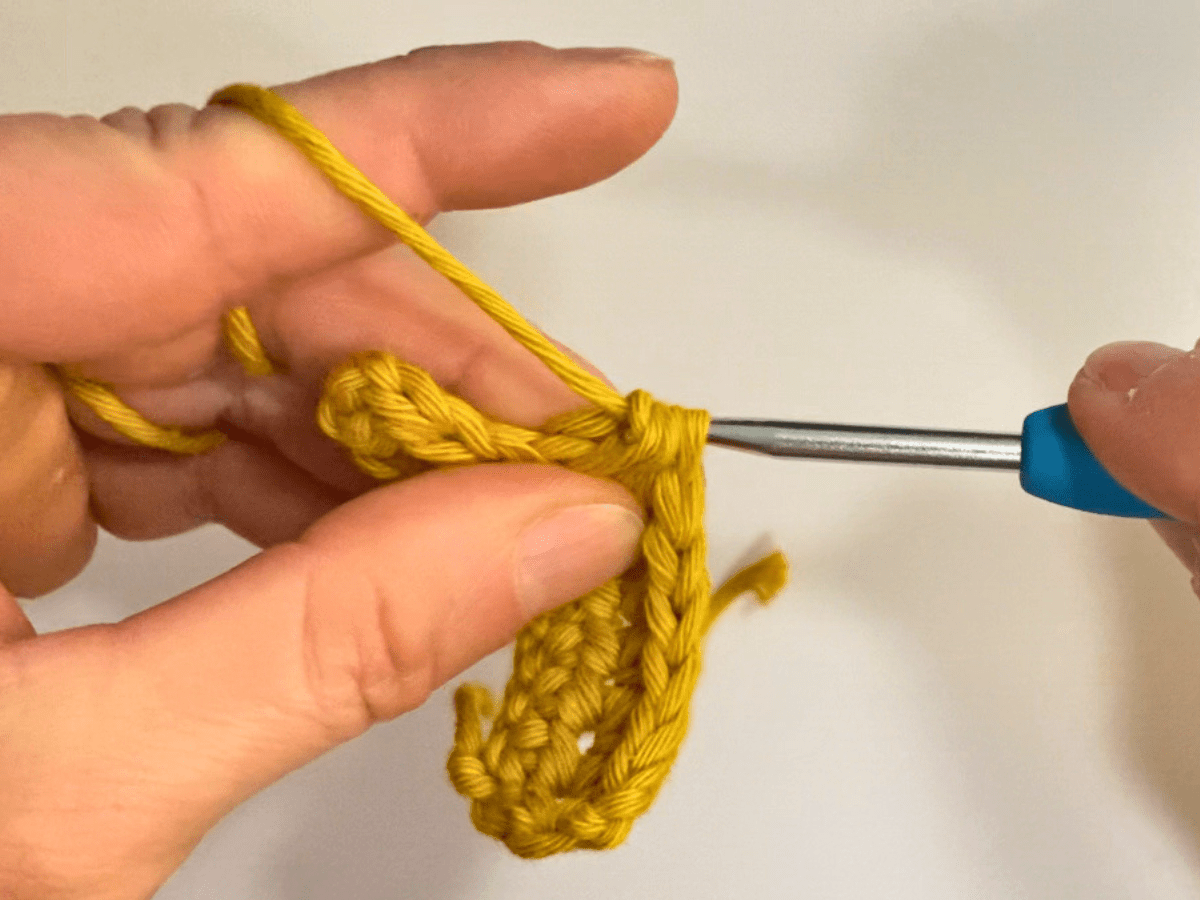
And this is how you make a half double crochet stitch. It might take some practice to get your hook through 3 loops at the same time, so don’t worry and take your time to master this skill.
A good advice is to pull down your work in order to create more space for your hook to get through. Also, if you still find it difficult, feel free to pull your yarn through one loop at a time.
Double Crochet
The double crochet stitch is taller than both the single crochet and the half double crochet. This height allows for a more open and airy fabric, making it suitable for lighter and more breathable projects. The double crochet is relatively easy and quick to work up. This makes it a popular choice for projects where you want more height without sacrificing speed.
It’s perfect for items like scarves and blankets, but it can honestly be used for a wide range of projects. Its openness allows for creative stitch patterns and designs.
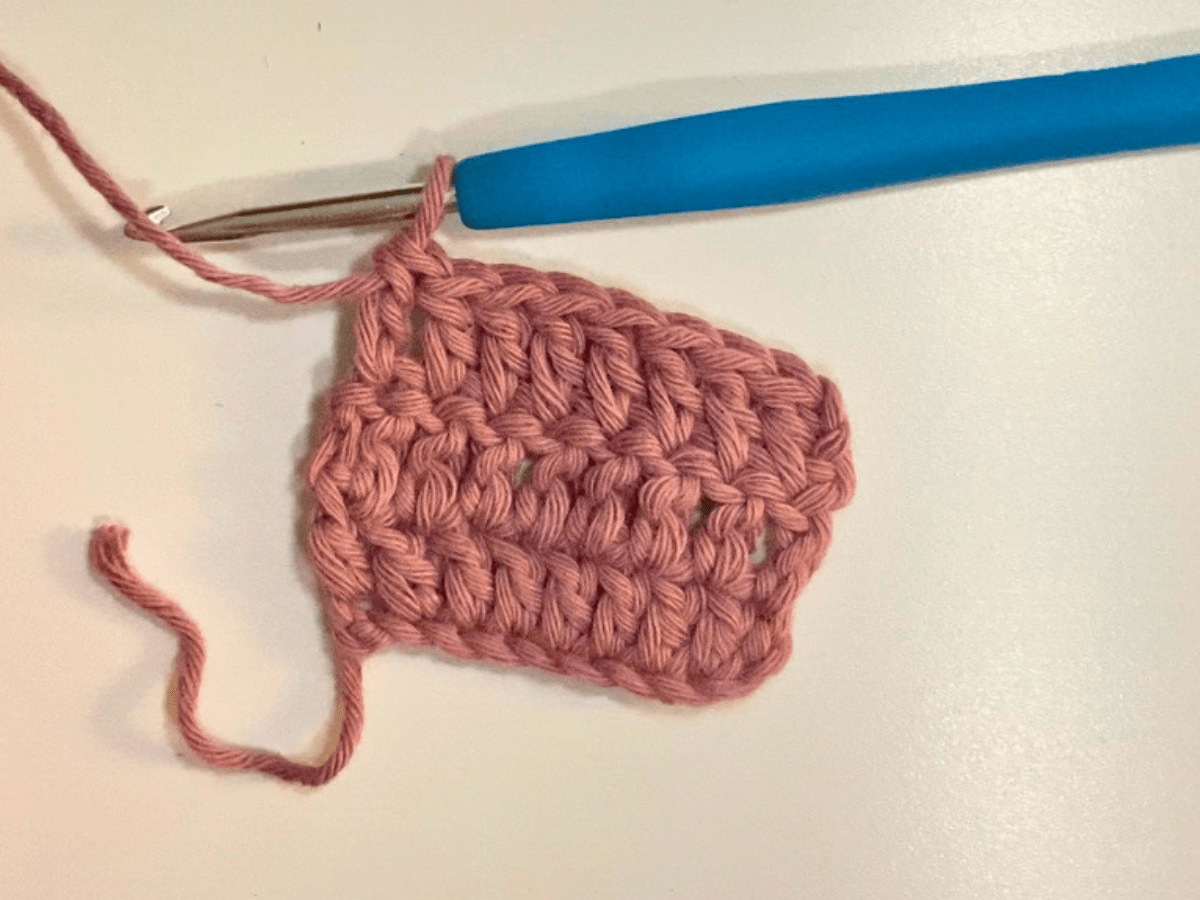
Abbreviation in patterns: (DC) in US term and (TR) in UK terms
To make a double crochet:
1. Yarn over and insert your hook into the desired stitch.
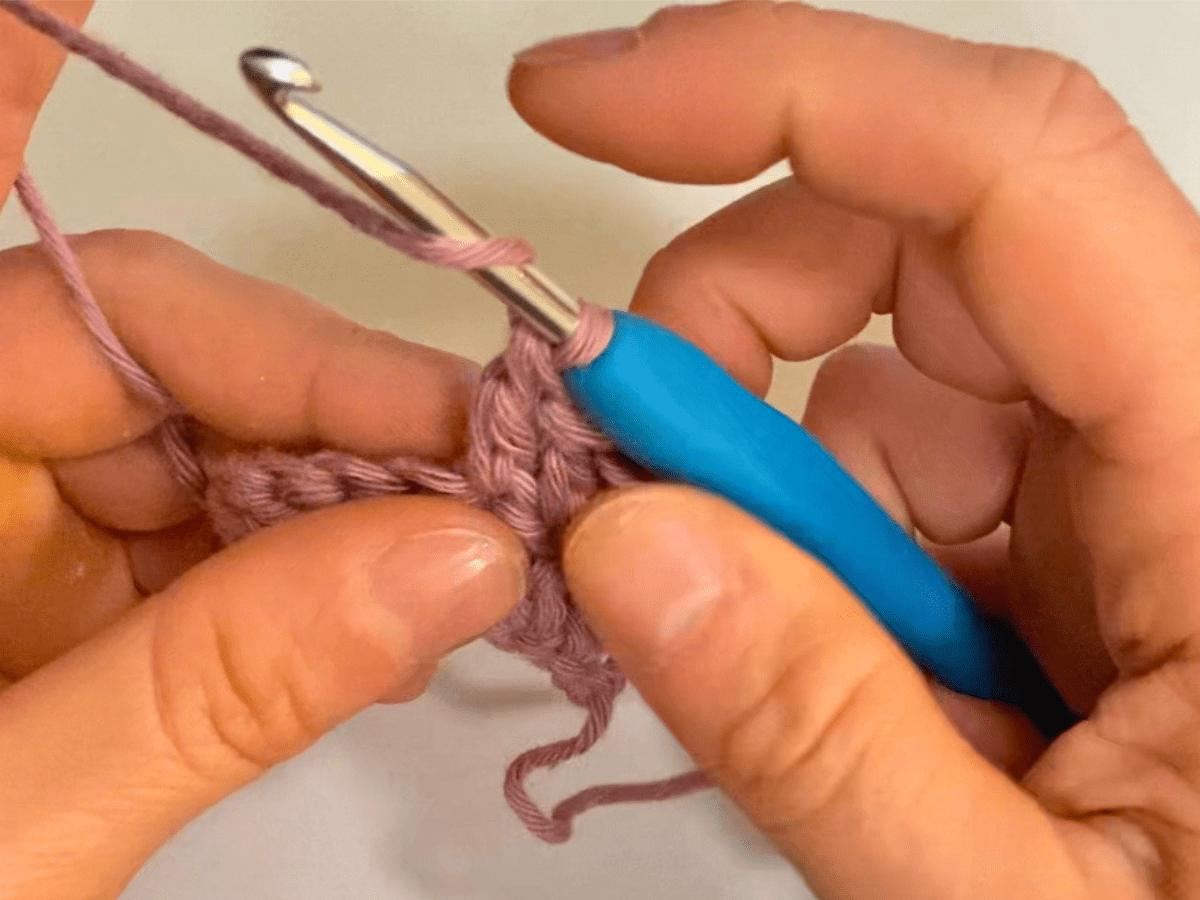
2. Yarn over and pull up a loop. You’ll have 3 loops on your hook.

3. Yarn over again and pull through the first 2 loops on the hook. You’ll have 2 loops left on your hook.
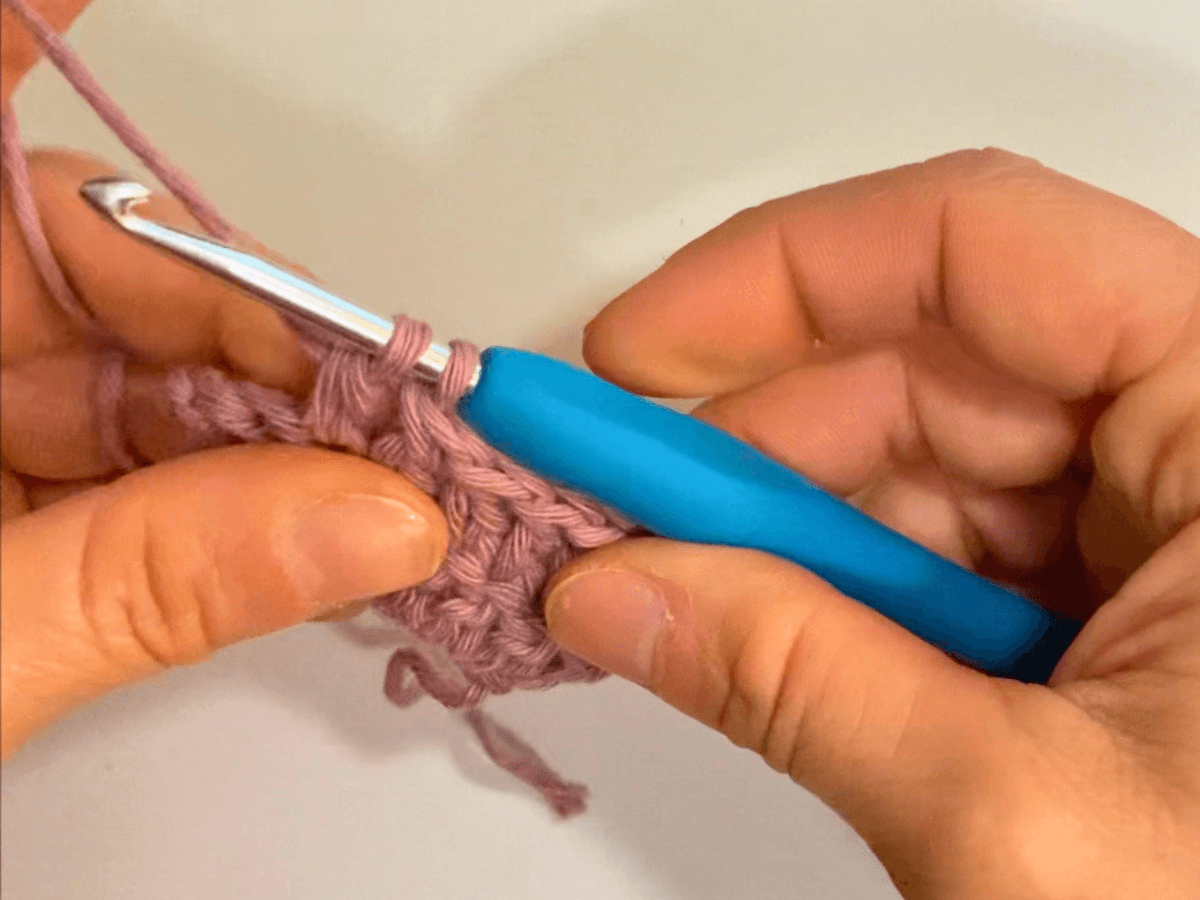
4. Yarn over once more and pull through the remaining two loops.

Here is your double crochet stitch! Now it’s time to practice it and gain momentum by repeating the stitch in a row and see how the texture differs from the single crochet and the half double crochet.
Treble Crochet
The treble crochet is one of the tallest basic stitches. It’s excellent for lacy and open designs. This height creates a more elongated and open stitch, suitable for projects with an airy quality.
Despite its increased height, the treble crochet is still relatively easy to learn and quick to work up, making it an efficient choice for projects where a taller stitch is desired. It is often used to create decorative edges or borders in crochet projects.

Abbreviation in patterns: (TR) in US term and (DTR) in UK terms
To make a treble crochet:
1. Yarn over twice.
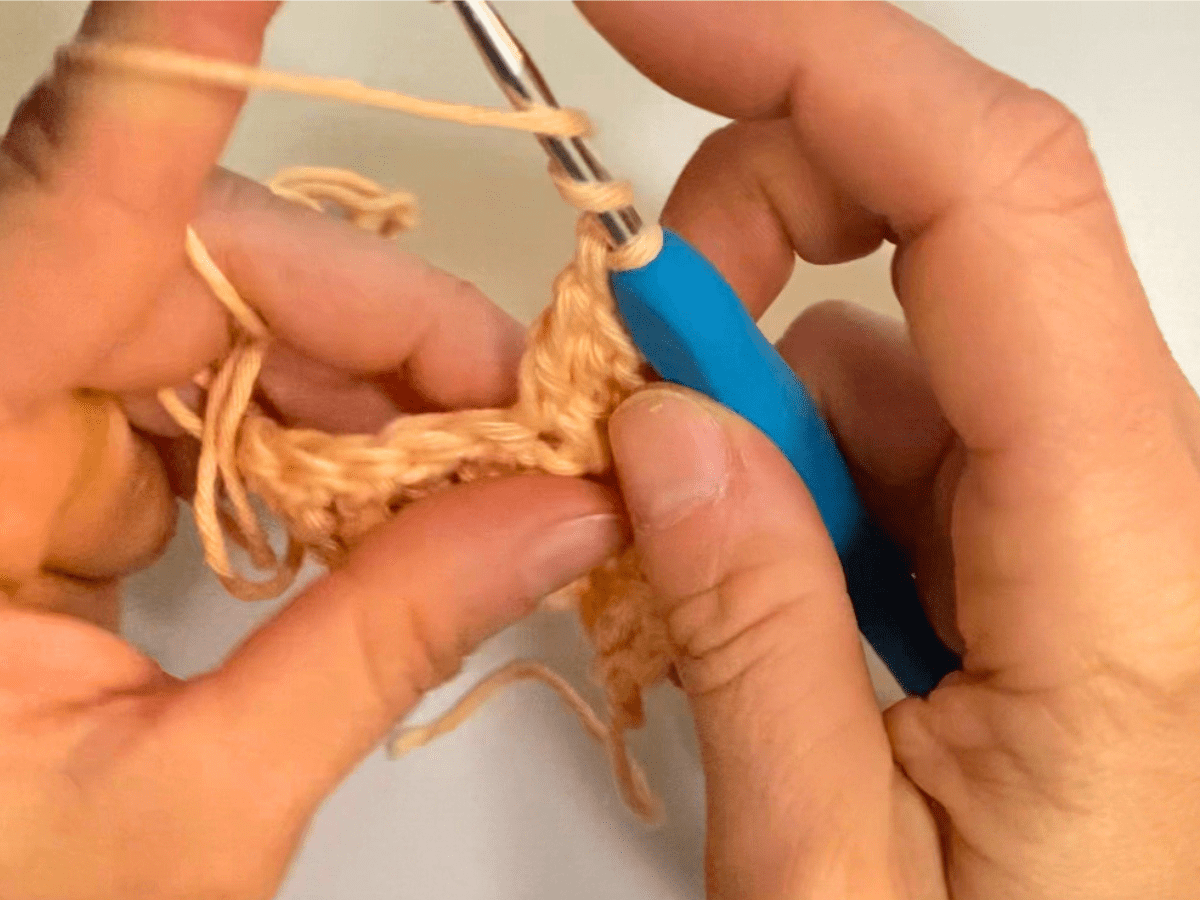
2. Insert your hook into the desired stitch.
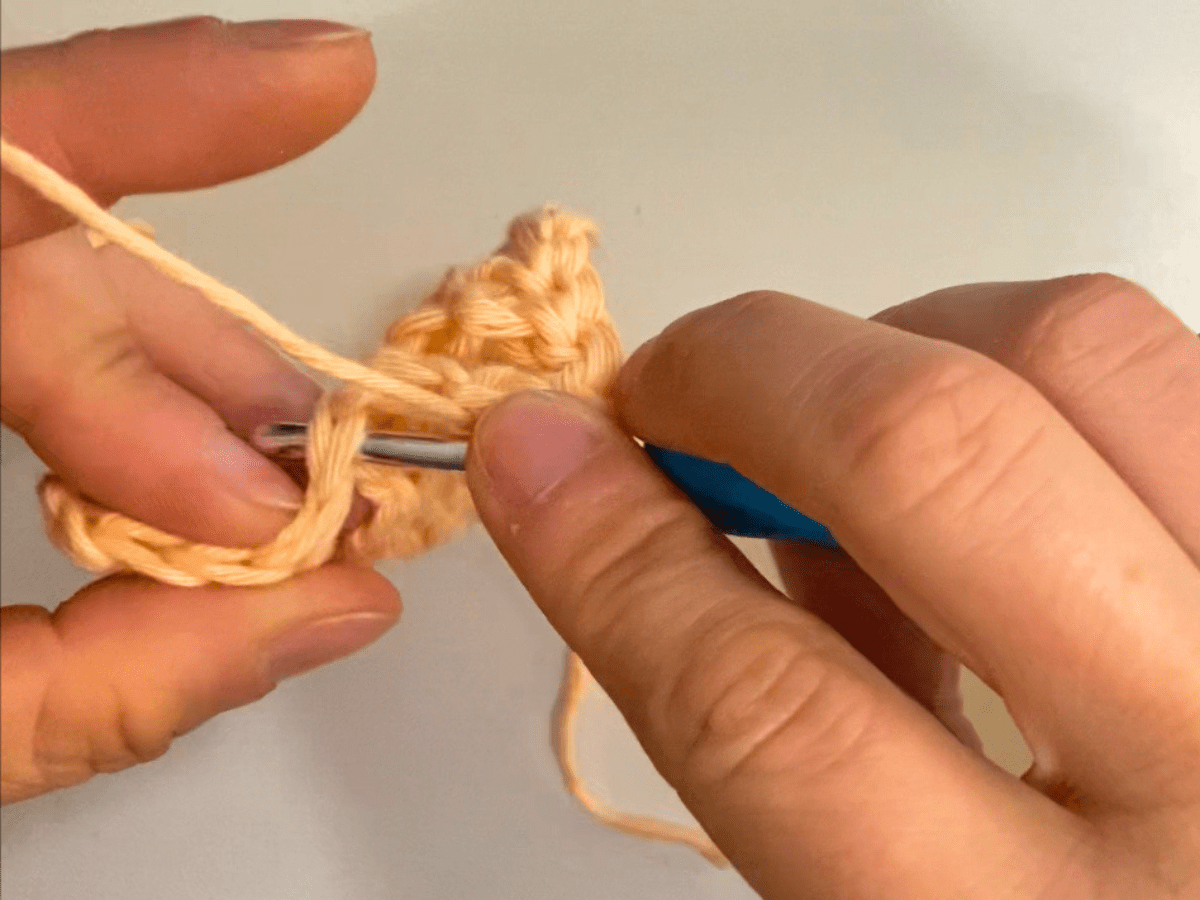
3. Yarn over and pull up a loop. You’ll have 4 loops on your hook.

4. Yarn over and pull through the first two loops on the hook. You’ll have 3 loops left on your hook.
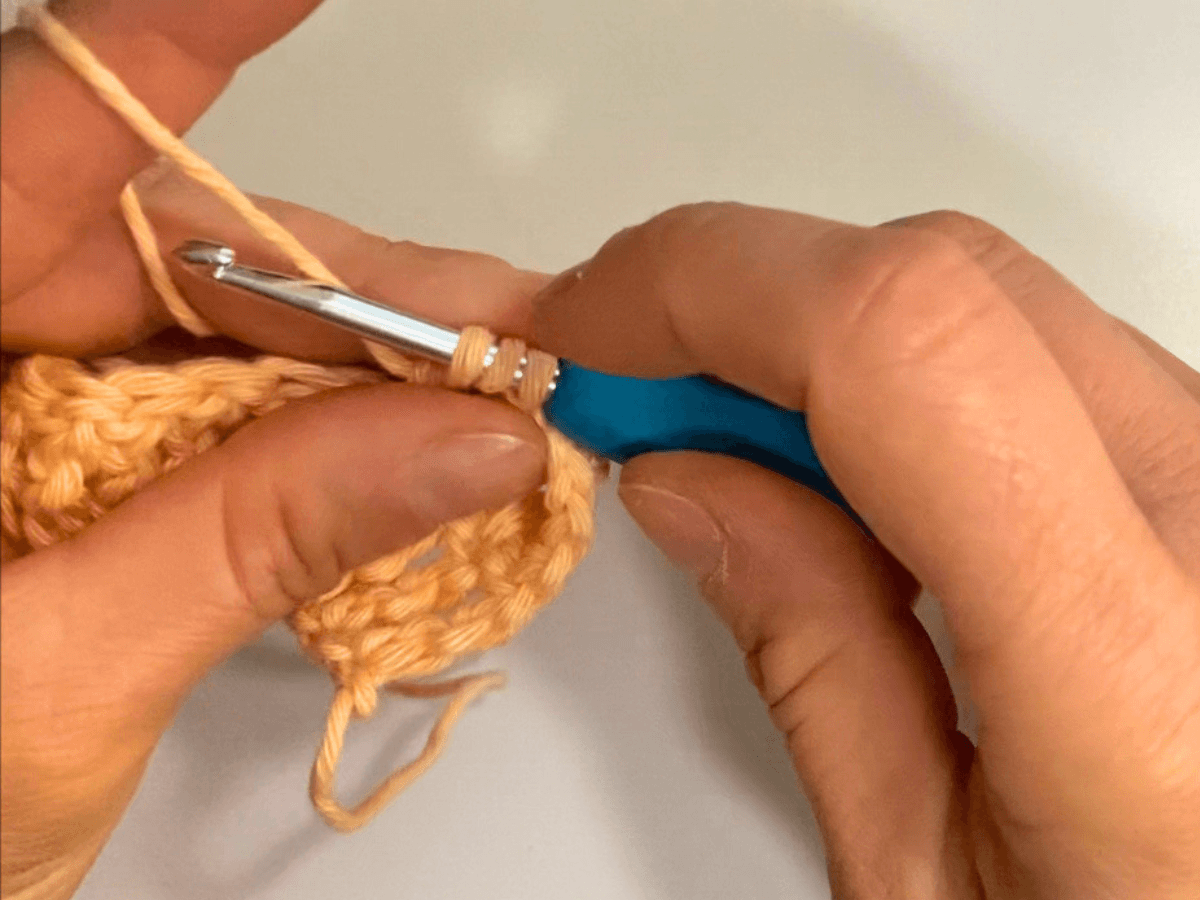
5. Yarn over and pull through the next two loops. You’ll have 2 loops left on your hook.

6. Yarn over once more and pull through the remaining two loops.

If you need to build height quickly in your project, the treble crochet is an excellent choice. Its taller stitches cover more ground with each row. So why don’t you practice it more by completing a few rows and by mastering the “yarn over twice” technique? Have fun!
Double Treble Crochet
And finally, the double treble crochet is the tallest of all the basic stitches, creating a very open and airy fabric. It allows you to cover a large portion of your project quickly. This is advantageous when you want to progress rapidly through your work.
Also, the elongated nature of the double treble crochet gives it a more complex appearance compared to shorter stitches. This makes it suitable for projects with intricate stitch patterns.

Abbreviation in patterns: (DTR) in US term and (TRTR) in UK terms
To make a double treble crochet:
1. Yarn over three times.
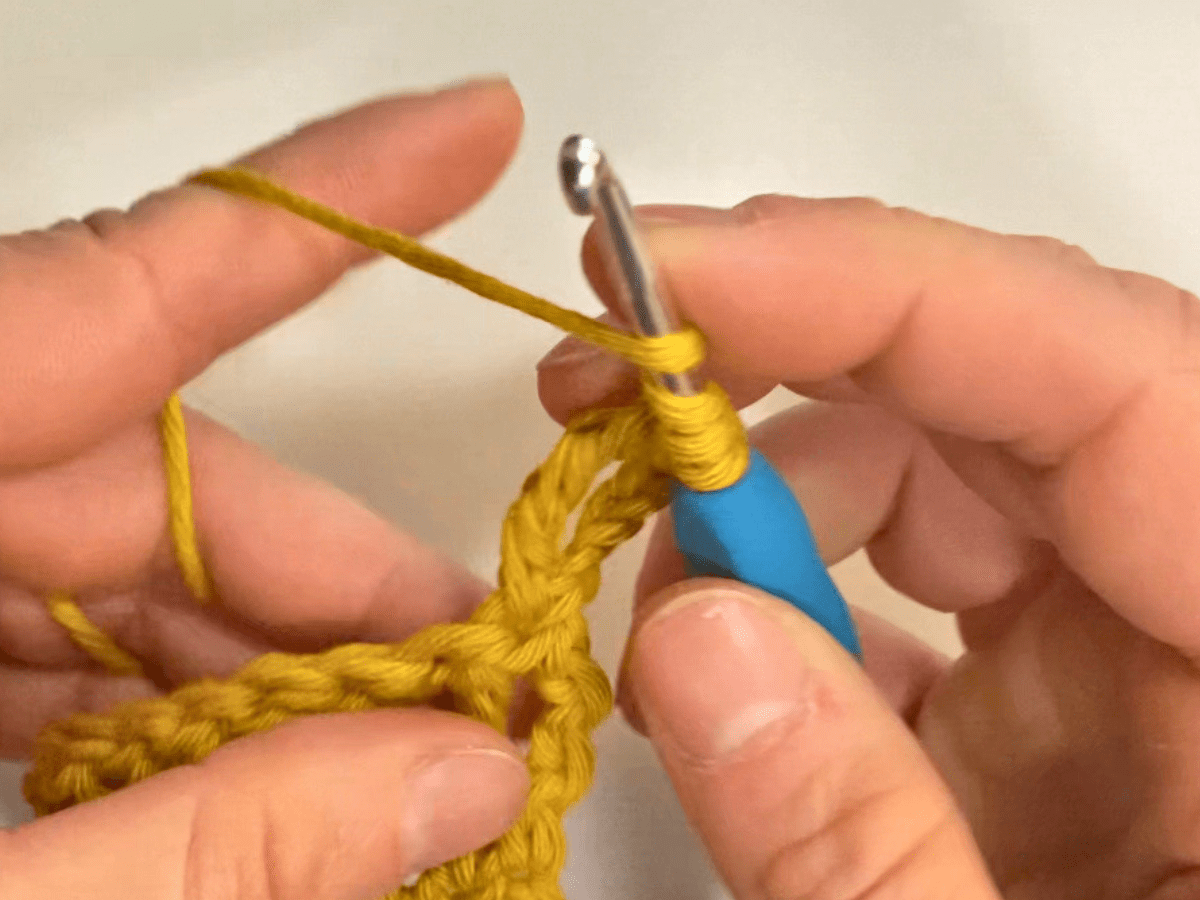
2. Insert your hook into the desired stitch.
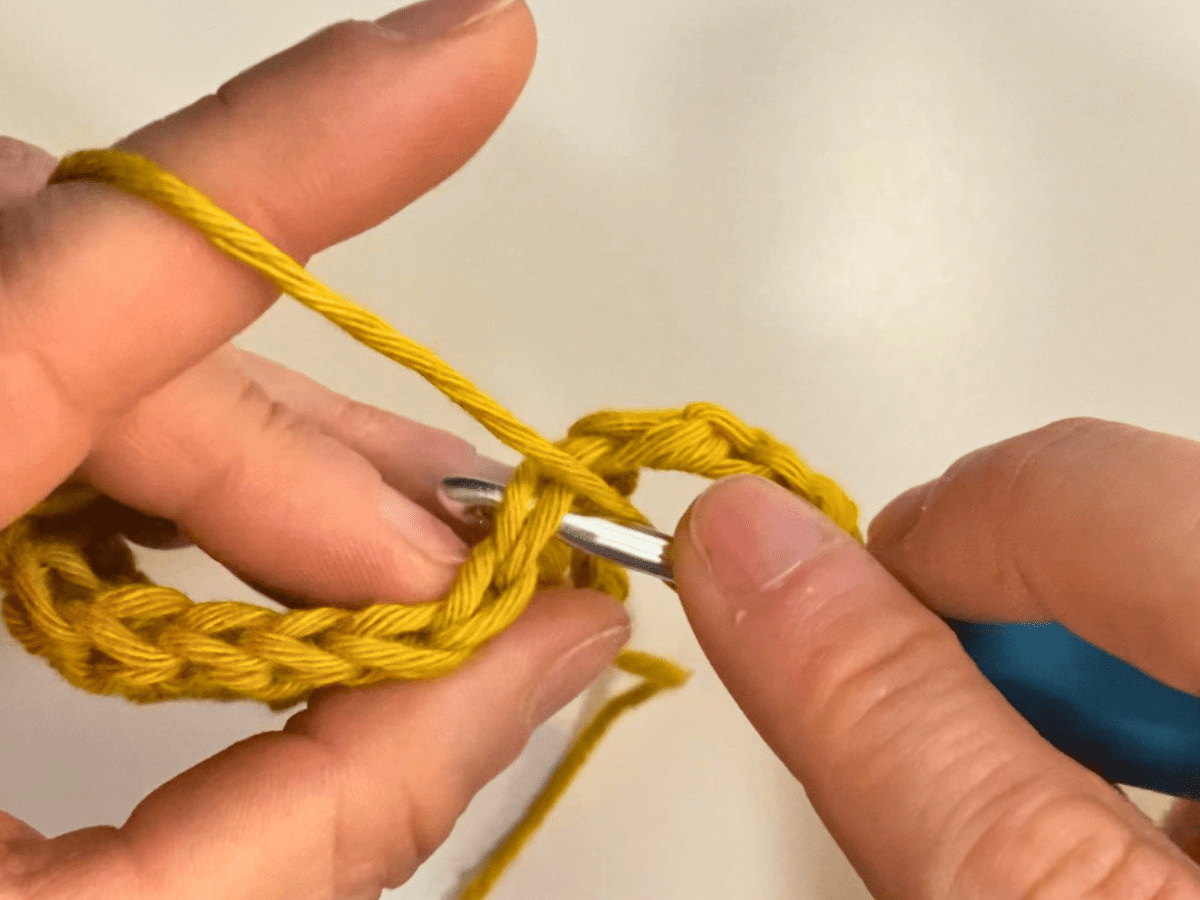
3. Yarn over and pull up a loop. You’ll have 5 loops on your hook.

4. Yarn over and pull through the first two loops on the hook. You’ll have 4 loops left on your hook.
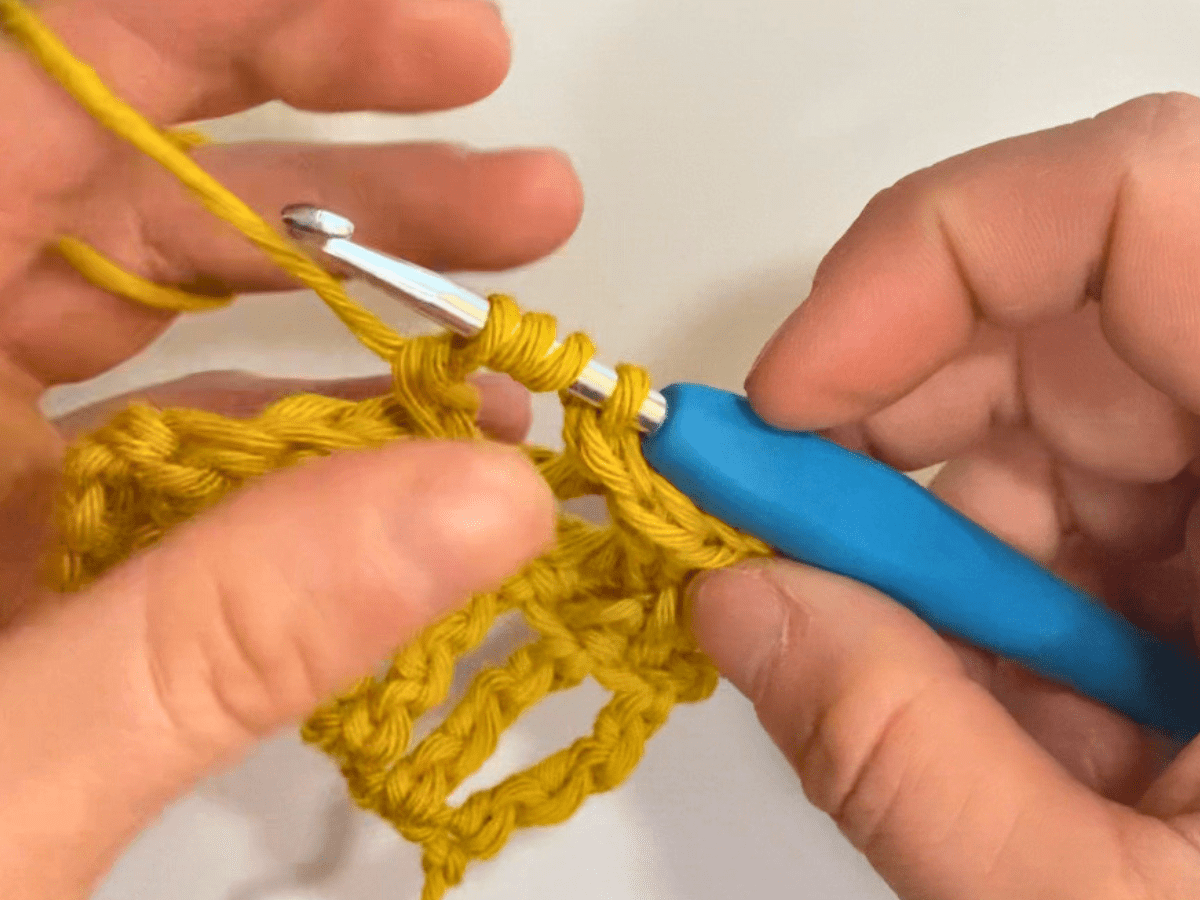
5. Yarn over and pull through the next two loops. You’ll have 3 loops left on your hook.
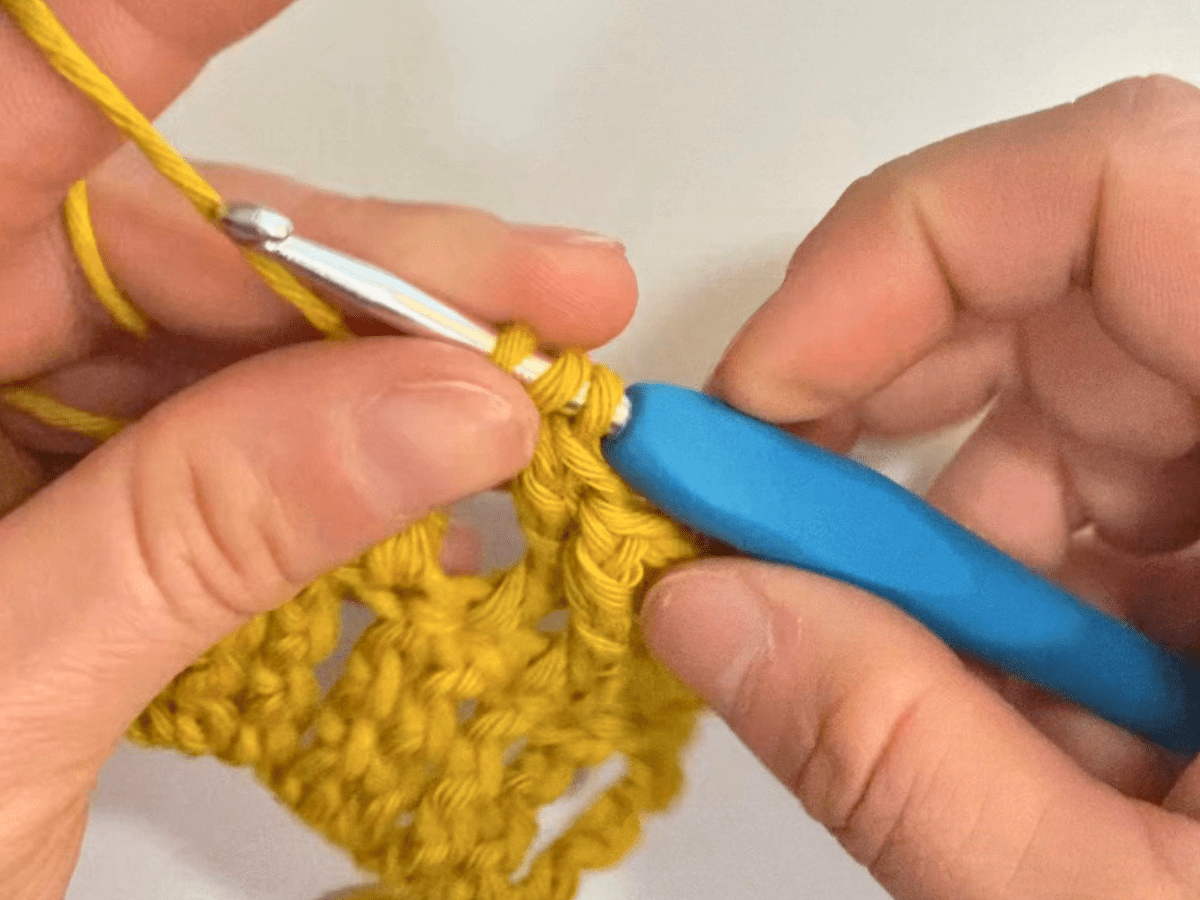
6. Yarn over and pull through the next two loops. You’ll have 2 loops left on your hook.
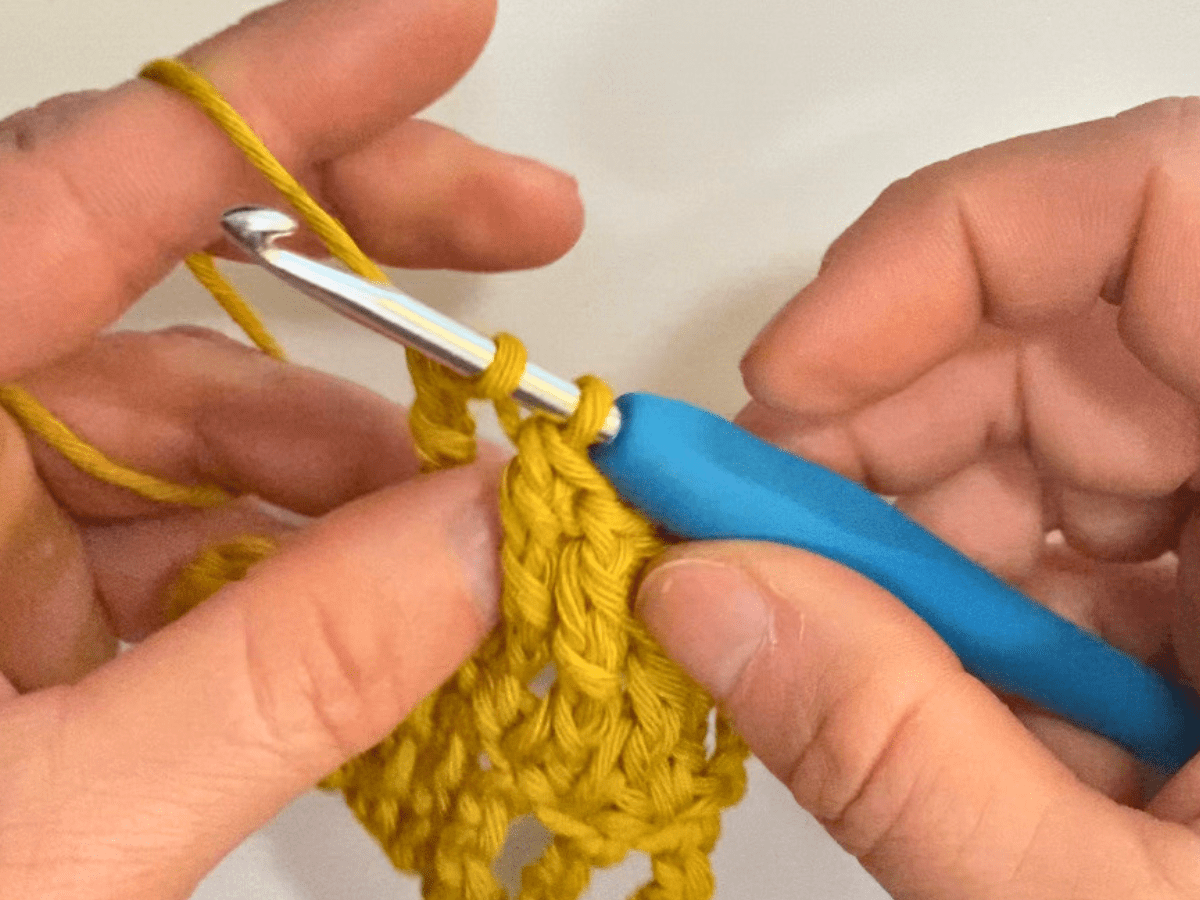
7. Yarn over once more and pull through the remaining two loops.
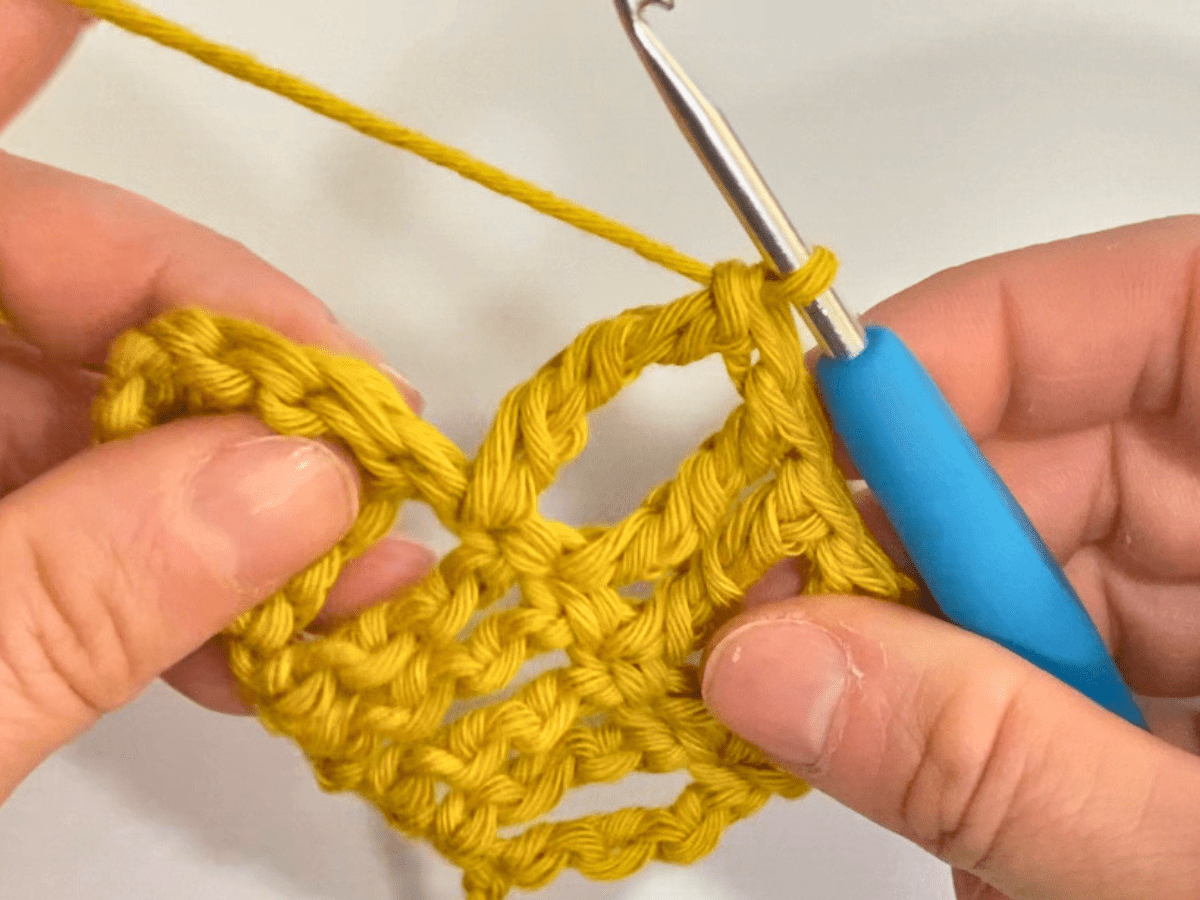
Congrats!! You can now make all the basic crochet stitches. With time and practice you’ll master all these stitches with no problem.
Conclusion
To wrap it up, learning the six basic crochet stitches is a fantastic starting point for any beginner. As you complete projects using these stitches, you’ll feel more comfortable exploring advanced techniques.
In particular, the basic stitches are incredibly versatile. They can be used to create a wide range of items, from simple dishcloths to complex blankets and garments.
Learning them will allow you to follow and interpret patterns with confidence. Even better, once you have a solid grasp of the basics, you can start combining and modifying stitches to design your own unique patterns and projects.
So, grab your yarn and hook, and let your creative journey begin.


